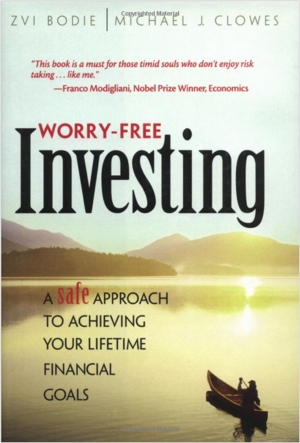I started this blog in August, 2007. Before that, I was writing a monthly article that appeared on a static web page that I designed by hand. Not pretty, really. When I flipped to this format, the old pages still existed on the server but not tied in to this site. It’s time I migrated some of the better articles to here, and clean up my server. This is the first of about a dozen articles I plan to move over the coming months. Let’s see which articles stood the test of time and which are showing their age. We start with a book review of Zvi Bodie’s Worry Free Investing.
I’ve read the book and wanted to share my thoughts.First, here is the link which provides a downloadable spreadsheet. The first assumption is that the TIPS (he switches between TIPS and iBonds, I won’t object as they are similar in that both are linked to the CPI) have a 3% return. This means 3% plus whatever CPI is running. He also assumes a replacement rate of 70% is the goal, as social security will provide some, and 100% isn’t the target as one doesn’t have to save ‘for’ retirement while retired. No arguments there from me either. The sheet comes up assuming that one starts saving at 35, retires at 65, and dies at 85. A savings rate of 21% is needed to accomplish this. I think 90 is more realistic, the rate has to jump to 24%. Start saving at 25, the rate drops to below 16%. I’d be great with this, only a visit to treasury direct shows that the current rate on iBonds is 1.4%. (note – as of April, 2013, the rate is zero) The real return has dropped by half. Leave the changes I made above (start at 25, live to 90) and the required savings rate shoots back up to 27%.

Had I read the book in 2003 and been sold on this plan, from a savings rate of 16% (which I wouldn’t worry about), I’d find, that as the real rates dropped, the new bonds I purchased would require a saving rate over 27%. This is worry-free?
I appreciated his anecdotes of the people who were on the verge of retiring to then meet up with the crash of 2000-2. And the Enron widow. These stories only reinforced my belief that much planning is needed in those final years, but he suggests that no amount of diversification will protect an investor from a long term bear market. I’m not convinced either way, but I still lean toward the 5-6 years of spending in bonds or cash equivalent, and the rest diversified among stocks, local and foreign.
I wonder if he’s changed some of his advice given that the real return on his suggested investment vehicle has dropped by over half.
He also contradicts “Stocks for the Long Run” stating that there is no ‘safe’ investing horizon for an investment in stocks. In the end I find this author to be misguided at best, and likely dangerous to your financial well being. You should save yourself the two hours and read other books from my list.

Good considerations, will keep in mind! Looking forward to more reviews.